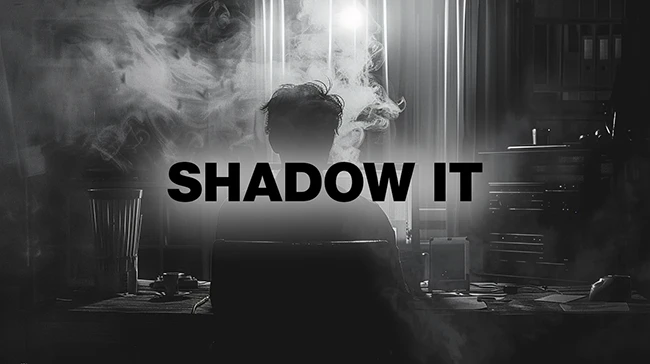The legal blind spot of shadow IT
Shadow IT isn’t just a security risk, it’s a legal one. When teams use unsanctioned tools, they can trigger compliance violations, expose sensitive data, or break contracts. Let’s look at where the legal landmines are and what CISOs can do to stay ahead of them.

Understanding the legal risks of shadow IT
When employees use unapproved tools, they may inadvertently violate laws and regulations designed to protect sensitive information. For instance, the GDPR mandates strict control over personal data. Unauthorized applications can compromise this control, leading to non-compliance and potential fines. Similarly, industries governed by regulations like HIPAA or PCI DSS face increased risks when shadow IT circumvents established data protection protocols.
Moreover, shadow IT can result in contractual breaches. Some business agreements include clauses that require adherence to specific security standards. The use of unauthorized software may violate these terms, exposing the organization to legal action.
John Harden, Director, Strategy & Technology Evangelism at Auvik, pointed to a recent case at a doctor’s office where a well-meaning workaround nearly caused a HIPAA compliance issue. “They implemented a shadow IT discovery tool and quickly identified unauthorized use of Airtable for patient intake processes,” he said.
The practitioners had independently adopted Airtable to streamline workflows. But they also unknowingly put sensitive patient data at risk. The use of Airtable wasn’t covered by an enterprise agreement, meaning the platform’s data protections weren’t aligned with HIPAA requirements.
“That presented them with a costly dilemma,” Harden explained. “Either spend $40,000 to $60,000 to bring Airtable up to compliance with an enterprise version, or spend the same on custom software.” But he said the real issue wasn’t the tool, it was the timing. “If they had known about the Airtable use earlier, IT and security could have collaborated with the team to find a secure, compliant, and maybe even cheaper solution.”
This kind of situation isn’t rare. The longer shadow IT goes unnoticed, the more expensive it is to fix.
Strategies to mitigate legal risks
1. Conduct regular audits – Regularly assess your organization’s IT environment to identify unauthorized tools and applications. This proactive approach helps in detecting shadow IT before it leads to compliance issues.
2. Implement policies – Develop and communicate clear policies regarding the use of software and devices. Ensure employees understand the importance of using approved tools and the legal implications of non-compliance.
3. Enhance employee training – Educate staff about the risks associated with shadow IT. Training should emphasize how unauthorized applications can lead to data breaches and legal consequences.
4. Utilize technology solutions – Deploy monitoring tools to detect and manage unauthorized applications. Solutions like Cloud Access Security Brokers (CASBs) can provide visibility into shadow IT activities and help enforce security policies.
5. Foster an open IT culture – Encourage employees to communicate their technology needs with the IT department. By understanding the tools employees find useful, IT can work to provide approved solutions that meet these needs, reducing the temptation to resort to shadow IT.
6. Collaborate with legal and compliance teams – Maintain close collaboration with legal and compliance departments to ensure that IT policies align with current laws and regulations. This partnership helps in addressing any legal issues that arise from shadow IT.
Building a legally defensible security program
The ability to build a security program that stands up in a courtroom is becoming as important as one that stands up to attackers.
“A focus on asset management and monitoring is crucial for a legally defensible security program,” says Chase Doelling, Principal Strategist at JumpCloud. “Your system must be auditable—tracking who has access to what, when they accessed it, and who authorized that access in the first place.”
This approach closely mirrors the structure of compliance programs. If an organization is already aligned with established compliance frameworks, it’s likely on the right path toward a security posture that can hold up under legal examination. According to Doelling, “Essentially, if your organization is compliant, you are already on track to having a security program that can stand up in a legal setting.”
The foundation of that defensibility lies in visibility. With a clear view of users, assets, and permissions, organizations can more readily conduct accurate audits and respond quickly to legal inquiries.
This is especially critical in the age of shadow IT. Doelling emphasizes that “the key is visibility, and the more you see, the more protected you are.” Without insight into what tools are being used and by whom, organizations are exposed to both security vulnerabilities and legal risks.
To make this visibility actionable, Doelling advocates for centralization. “The most efficient way to achieve this clarity is through a unified platform that serves as a single source of truth, simplifying the process of tracking assets and permissions,” he says. This kind of platform not only streamlines security operations but also enables third parties, like auditors or legal professionals, to understand and verify data.
When applied to shadow IT, the benefits become even clearer. “By extending this perspective to shadow IT, you can automate tracking down to the individual user, ensuring that even unapproved IT assets are accounted for,” Doelling notes. This level of insight helps reduce the hidden risks and inefficiencies caused by shadow IT, including escalating costs and compliance gaps.
“As shadow IT becomes a more pressing concern, managing it effectively is no longer optional but essential,” Doelling concludes. “It’s not just about security, it’s about being able to defend your program legally when it matters most.”